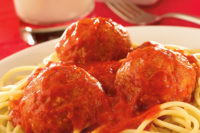Lasting longer

It’s not just baby boomers trying to defy the aging process; it’s the fresh foods they purchase and prepare. Shopping for meat and poultry is nothing like it once was when boomers were just youngsters, fascinated by the in-store butcher who chopped, ground and filleted primal cuts and whole birds to customers’ specifications. Today, it’s done either behind the scenes or completely off the store’s premises.
Such pre-packaged raw meats—which must maintain a fresh, pink appearance while in transit through an often lengthy distribution system prior to merchandising in the retail case and ultimately cooked and served for dinner—are the norm at increasingly popular private-label store formats such as Trader Joe’s and Fresh & Easy. Even national chains such as Albertsons and Safeway don’t allow unpackaged raw chicken into their stores for food-safety reasons.
To ensure quality, meat processors employ a number of ingredient solutions to extend shelf life and reduce the incidence of microbial spoilage and oxidative rancidity, the two most limiting factors in raw meat distribution. Rancidity is responsible for off-flavor development and color loss. Some microbial growth renders meat inedible, as bacteria and mold can cause visible deterioration and offensive odors. Pathogen propagation, on the other hand, is typically undetectable by humans, but can make undercooked meat a lethal weapon.
Artificial preservatives such as butylated hydroxyanisole (BHA), butylated hydroxytoluene (BHT) and tertiary butylhydroquinone (TBHQ) have long been the standard to ensure an economically sensible shelf life for packaged raw meat products. But today’s clean-label seeker does not want to see that such “chemicals” have been added, and as a result, processors are turning to all-natural solutions that suppliers are now making more readily available.
For example, rosemary extract, which as the name suggests, is an extract obtained from the Rosmarinus officinalis bush. It can be labeled as simply “natural flavor” or “rosemary extract” on many applications. As a concentrated source of carnosic acid, a potent antioxidant, rosemary extract has been shown to slow the development of oxidative rancidity in meat. In most applications, rosemary extract is invisible to the end user, as it does not impact the meat’s organoleptic properties.
Not as common as rosemary extract, but quickly gaining the interest of meatpackers, green tea extract can also delay the onset of oxidative rancidity in meat. Dried green tea extract is very high in antioxidants classified as catechins, half of which are highly effective epigallocatechin gallate (EGCG), as well as other antioxidants including gallic acid, carotenoids and tocopherols.
Speaking of which, tocopherols are a class of Vitamin E with powerful antioxidative properties. They have long been used as a natural shelf-life extender in many products and have application in raw meat. Inclusion can be cleanly identified on ingredient statements as vitamin E or mixed tocopherols, usually with a parenthetical explanation of being added to maintain freshness, so not to be confused with inclusion for fortification or nutrition-profile enhancement.
Prunes, now more commonly referred to as dried plums, have become a go-to for many meat processors wanting to extend product shelf life. This is because dried plums contain a number of organic acids, primarily malic acid, that work synergistically with inherent high-antioxidant phytochemicals to suppress microbial development in raw meats.
Fermented carbohydrates are also becoming increasingly popular natural raw meat shelf-life extenders. This is the function of the inhibitory substances that lactic-acid bacteria produce and excrete during the fermentation, ranging from hydrogen peroxide and free fatty acids to antibiotics and bacteriocins.
And let’s not forget that since January 2002, activated lactoferrin has been available for use on fresh beef as a safeguard against pathogenic bacteria. A multi-functional ingredient, activated lactoferrin protects meat in three key ways: it detaches pathogens already attached to meat, prevents other pathogens from adhering to meat and inhibits pathogen growth. It does all this without impacting the meat’s taste, appearance or nutritional qualities.
So how long is too long to last? Only time will tell.
Looking for a reprint of this article?
From high-res PDFs to custom plaques, order your copy today!





